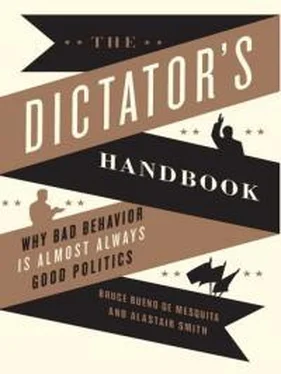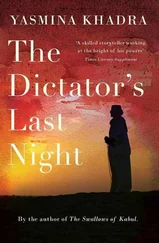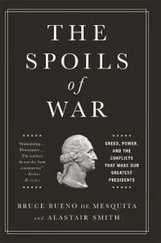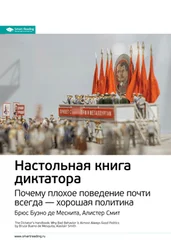In 2002, Pew undertook a study of values and opinion in forty-two nations. One question asked about people’s view of the United States. In Pakistan 69 percent of people reported an extremely unfavorable view of the United States. In Egypt the figure was 79 percent. In the other forty nations an average of only 11 percent of the people shared this extremely negative view of the United States. But then Pakistan and Egypt received an average of $1.6 billion in economic and military aid from the United States in 2002, while the other forty nations averaged only $97 million in aid. The pattern is borne out in detailed statistical analyses. People in nations receiving lots of US aid seem to hate the United States. Of course, much may have changed since 2002, and it would be fascinating to see whether our assessment continues to be borne out in future surveys.
Our account of aid may seem to paint the United States as international bad guy number one. But the United States is far from the only aid donor. While the United States is the largest overall donor, as a proportion of its economic size it gives relatively little, about 0.2 percent of GDP. Scandinavian nations give over 1 percent of their economic output in foreign aid. Provided the policy rewards that a foreign power can provide to a democrat’s supporters are worth more to the supporters than the rewards that could be directly purchased with the money, democrats support aid. Other nations and agencies buy favors too, if not perhaps on the same grand scale that the United States can afford. In fact, careful analysis shows that even the seemingly generous Scandinavians give aid in exchange for policy concessions rather than for altruistic reasons. They particularly like to use aid to gain trade concessions and prosocialist ideologies in recipient regimes.13
Aid agreements are notorious for being tied to conditions that help the donor. This means that the agreement often specifies how, and more importantly where, the money is spent. For instance, Germany might give a recipient money, but only if they use it to buy German tractors. This might seem an inefficient way to reward tractor manufacturers. However, international trade laws often forbid direct subsidies. Further, tied aid can bring future business, such as spare parts and service. Canada is notorious for high levels of tied aid, 60–75 percent of all its aid. Scandinavia and the UK claim to have the lowest levels of tied aid, but even there, informal tying is common. For instance, Denmark had allocated $45 million to repair ferries in Bangladesh. Rather than repair the ferries locally, Denmark proposed taking the ships to Denmark and repairing them there at four times the local cost. Amid protest from the Bangladeshi government, Denmark decided to simply cancel the whole scheme so neither the Bangladeshis nor the Danes benefited.
Just as the United States buys security and trade concessions with aid, and the Europeans trade aid for business concessions, so too does Japan. Whales need to fear Japanese benevolence. American voters like pork. In contrast, Japanese voters like blubber, and Japanese leaders have been working hard to deliver. In 1986, the International Whaling Commission (IWC) instituted a moratorium on the commercial hunting of whales. While this ban was popular with the people of most nations, the citizens of Iceland, Norway, and Japan want to resume hunting. Currently the Japanese hunt a small number of whales through a loophole that allows hunting for scientific research. These whales, of course, end up being eaten. The Japanese government buys votes on the IWC with foreign aid. Recently, behind Japan’s efforts, the IWC’s membership has swelled to include nations with no history of whaling. Some of these recent members, such as Laos, Mali, and Mongolia, are landlocked. Japan’s efforts have been rewarded with growing support for the resumption of whale hunting.
The Impact of Aid
Example after example highlight the simple fact that aid is given in exchange for policy concessions far more readily and in far larger quantities than to reduce poverty and suffering. Following World War II, the rich nations seem genuinely to have thought they could free the world of poverty through their generosity. But no sooner did aid begin to flow than the politics of survival intruded on the noble goal of reducing misery. It should not be surprising that politics prevailed over benevolence. The record is unambiguous: foreign assistance has proven ineffective at alleviating poverty and promoting economic growth.
In the aftermath of World War II, Europe faced many challenges. Even the victors had suffered enormous human and economic losses. The United States launched a widespread relief program known as the Marshall Plan. Adjusted for inflation, the United States pumped over $182 billion in economic assistance into Europe between 1946 and 1952. Britain was the largest recipient, followed by West Germany, France, and Italy.14 The United States’s goals were to build stalwart states aligned against communism. To achieve these ends, the United States needed an economically strong Europe. States that were willing to combat communism and follow US-dictated economic plans got aid; those not willing to do so, didn’t.
Over the entire postwar period, total US economic assistance was nearly $1.3 trillion. Military aid over the same period was about $650 billion. To give some perspective, together these economic and military aid packages are roughly twice the size of the 2009 US stimulus package and Troubled Asset Relief Program (TARP) funds put together.
The success of the Marshall Plan proved hard to replicate. Trillions of dollars have been pumped into developing economies, yet there is precious little to show for it if we measure performance by assessing improvements in the quality of life. As we’ve seen, aid has done virtually nothing to relieve poverty.
Among policy makers, this record has prompted a fierce debate about the efficacy of aid. For critics, it is all too easy to point to many aid-dependent states in Africa that are poorer now than they were at independence. The development community likes to counter that such a direct comparison is unfair and argues that, while aid-dependent nations have performed poorly, they would have done even worse without aid. This defense, while wrong, is a sensible argument that needs to be taken seriously.
We cannot simply condemn the aid enterprise just because nations that received aid performed so poorly. To understand why, consider the following provocative statement: hospitals kill! There is plenty of evidence to support this claim. The likelihood of dying is much higher for a person in a hospital than for a person who is not. Of course, most of us instantly see the error in the evidence. The people in hospitals are sick. Healthy people are not to be found staying in hospitals. But this kind of error from looking at statistics without thinking about where they come from is all too common.
A colleague of ours, Peter Rosendorff, organized a petition and appealed to the Santa Monica City Council to put a crosswalk at a dangerous junction near his former house. The City Engineer said that quite to the contrary, the city was planning to take out all the crosswalks because their study showed that pedestrians were more likely to get killed in crosswalks than anywhere else. The children of Santa Monica should be grateful to Peter. He took the time to explain that the result was not because crosswalks were inherently more dangerous but rather, they are where people cross the road.
Assessing the true impact of hospitals or a particular treatment or drug is difficult unless we understand who is being treated. The medical community uses randomized drug trials to test the efficacy of medicines. Patients are randomly split into two groups: half get the medicine being tested and half get a placebo. The effectiveness of the drugs is determined by comparing the performance of the two groups. If, alternatively, the medicine is given only to the sickest patients, then even if it is an effective treatment the group getting the medicine might do worse than the group that did not. Likewise, if aid agencies target aid at those nations facing the most serious problems, then aid could appear ineffective even if it was actually working.
Читать дальше












